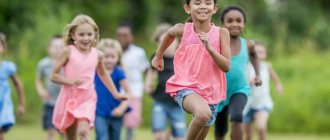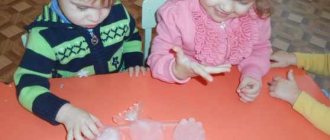Swimming in kindergarten.
Swimming is one of the most important links in raising a child - it promotes comprehensive physical development, stimulates the activity of the nervous, cardiovascular and respiratory systems, and significantly expands the capabilities of the musculoskeletal system.
It is one of the best means of hardening and forming correct posture. Swimming is a powerful emotional and positive factor that allows you to solve important problems. Helps correct poor posture, prevents flat feet, helps relieve muscle tone, develops coordination, rhythmic movement, and increases the body's motor capabilities. Systematic exercises in the pool improve the functioning of the circulatory and respiratory organs. Has a powerful hardening effect.
The main goal of the classes is to teach preschool children to swim; hardening and strengthening of the child’s body; teaching each child to be aware of physical exercise; creating the basis for versatile physical development.
During the classes, tasks on forming are solved:
- swimming skills;
- taking care of your health;
- personal hygiene skills;
- the ability to control your body in an unusual environment.
What effect does swimming have on a child’s body?
Swimming improves the functionality of the nervous system, its autonomic functions, and increases the mobility of nervous processes. It is especially useful for those children who are overly excited. The water temperature and monotonous cyclic movements have a calming effect on the nervous system, make the child calmer, and ensure sound sleep.
During immersion and swimming, unique conditions are created for the functioning of the heart and the entire cardiovascular system. During swimming, regular bathing, or just staying in the water, changes occur in the composition of the blood.
Swimming hardens the human body, increases its resistance to temperature fluctuations and immunity to colds. Water has both mechanical and thermal effects on the skin. It washes away dirt, sweat, sebum, and the top layer of epithelium from the skin, i.e. cleanses the skin, improves skin respiration and strengthens the skin itself.
Swimming affects a child's growth. Swimming is an indispensable tool for creating a “muscle corset.” Swimming is one of the means of treating the consequences of limb fractures and spinal cord diseases associated with motor dysfunction. Swimming helps reduce excess fat deposits. At the same time, in very thin children, these activities help to increase subcutaneous fat, which, together with an increase in muscle strength and volume, improves posture.
Organization of swimming lessons in kindergarten.
Swimming lessons should be held no earlier than 40-50 minutes after a meal and no later than 1.5 - 2 hours before bedtime. In a kindergarten, the most acceptable time for swimming lessons is considered to be: before lunch - from 9:30 a.m. to 12:00 p.m.;
Swimming training takes place in the form of subgroup lessons. For activities in the pool, children are divided into two subgroups. Depending on the age, the number of children in subgroups will vary.
Swimming training at the preschool educational institution is conducted for each group 2 times a week.
- the younger group studies for 15-20 minutes;
- middle group – 20 -25 minutes;
- senior group – 25 minutes-30 minutes.
- preparatory group – 30 -35 minutes.
Classes in the pool in our kindergarten are held starting from the second youngest group (3 years). The first lesson takes the form of a tour of the pool, during which the instructor introduces the rules of behavior in the pool (shows the children where and how to undress and change clothes, put on a bathing cap, how to wash in the shower, and walk along the walkway).
The training consists of three stages:
- getting used to water;
- water development;
- mastering swimming movements.
In our kindergarten, swimming is given great importance. This work is carried out by a swimming instructor.
About the importance of swimming for a child’s body.
Swimming in the pool for children of early preschool age for the purpose of improving their health and teaching them practical skills began to be introduced in our country and abroad in the 70s of the last century (although in fact the roots of this method go back to ancient times). It is known how often accidents on the water are recorded, occurring due to the fact that the victims, including children, do not know how to swim. If children from an early age were taught to float freely on the water and swim at least a short distance, and also developed a culture of behavior on the water, then many would be protected from possible misfortune.
At the same time, the main goal of teaching preschoolers to swim is to promote their health and hardening, and ensure comprehensive physical training. Bathing, swimming, games and water activities have a beneficial effect on all body systems.
GUIDELINES.
It is recommended to start learning to swim with preparatory exercises on land. This allows children to master movements in the water faster and more correctly. The fragility and immaturity of the child’s body require careful consideration of the abilities, inclinations, and most importantly, the capabilities of each child. Only with strict consideration of gender, age, level of physical development, health status, susceptibility to colds, water habits and changes in temperature conditions, individual reactions to physical activity can the most effective methods of learning to swim be found. The methodology for teaching swimming to preschoolers is based on the basic didactic requirements of pedagogy and is educational and developmental in nature.
Objectives of swimming training by age group.
Second youngest.
- Teach children not to be afraid to enter the water, teach them to splash in it.
- Teach how to move in the water along the bottom of the pool in different ways at different depths.
- Learn to dive into water and open your eyes in it. Learn to hold your breath underwater, dive. Learn to exhale into water while immersing yourself up to your nose. and with immersion of the face and head.
- Learn to lie on the water (on your chest), holding the handrail with your hands, holding the teacher’s hands with support. Learn to lie down on your own.
- Learn to perform chest slides with auxiliary equipment.
When teaching swimming to young children, much attention is paid to the initial stage of developing the correct skills.
Learning each swimming exercise (movement) requires a certain readiness from the child, so it comes down to play.
Middle group
- Learn to move independently in the water in different directions, in different ways.
- Learn to dive into water, hold your breath, dive under a toy. Learn to dive and collect objects from the bottom of the pool.
- Learn to exhale into the water while immersing your face and head.
- Learn to lie on the water with the support of a teacher and independently.
- Learn to glide on the surface of the water on your chest and back with the help of an adult and with auxiliary equipment.
- Learn to perform movements with your legs and arms on land and in water as when swimming crawl.
- Develop physical qualities: strength, endurance, speed.
In children of middle preschool age, the swimming skills and abilities acquired in classes in the younger group are consolidated. Much attention at this age is paid to instilling organization and discipline in children. The training uses a variety of exercises for special training and games to master movements in water. Games for acquiring diving skills.
Senior group.
- Learn to immerse yourself in water for longer periods of time.
- Learn to exhale into the water (alternate inhaling over the water with exhaling into the water).
- Learn to slide. On your chest on your back, pushing off with your feet from the bottom and walls of the pool.
- Learn to slide in combination with exhaling into the water.
- Teach coordination movements with your feet in the water, leaning on your hands, lying on your back and chest.
- Teach leg movements in sliding on the chest, on the back (like a crawl) with and without a movable support (boards).
- Training in coordination abilities in water. teach arm movements in swimming on the front and back.
Classes in the senior group include: exercises and games for the development of hands, breathing exercises, exercises for special training, games for mastering sliding skills, relay race games.
Preparatory group.
- Learn to lie in water on your back and chest for a long time.
- Learn to slide in water on your chest, on your back in combination with movements of your legs and arms.
- Learn to dive into the water.
- Teaching easier swimming methods with footwork and supporting stroke movements of the arms (on the back, on the chest).
- Development and improvement of coordination abilities in water, learning combinations of movements with arms and legs while holding the breath and exhaling into the water.
Games and entertainment on the water
Water games help solve a number of pedagogical problems. The game develops the child’s strong-willed qualities, feelings of camaraderie and collectivism. By developing and strengthening the body, it consolidates and improves swimming skills. By increasing the emotionality of the activity, the game is used as relaxation and entertainment. However, some negative points should also be noted. Carried away by the process of the game and trying to become winners, children stop monitoring the accuracy of the elements of swimming movements and perform them incorrectly. Repeated repetition of incorrect (from the point of view of swimming technique) movements can lead to them becoming habitual. Therefore, games used to reinforce any skill should be designed so that the correct execution of the movement is the main condition.
Simple plotless games are played mainly with beginners, so that they feel more confident in the water and learn how to move. When this goal is achieved, you can move on to a complex game with a plot and competitive elements.
The explanation of the rules of the game should be brief and figurative. If the movements are complex, then the story is accompanied by a demonstration. First you need to play the game on the shore, and only then in the water. You cannot remove individual participants from the game before it ends.
Swimming is a family affair
Swimming is an effective strengthening and healing tool for all family members, from the youngest to the oldest.
In water, a person finds peace and balance, stress and anxiety are absent, the number of family quarrels and scandals is significantly reduced.
By exercising in the water with children, you not only help them grow healthy, but also unobtrusively educate them, because... in the process of training such qualities as discipline, determination, and willpower are formed. But it is precisely these that children sometimes lack so much.
You will get to know your child better, learn to understand each other, and become more friendly.
So, do you want to be a healthy and friendly family?
Swim and teach your children to swim!
How to overcome your fear of water?
If a student is afraid of water, you should not convince him otherwise. To achieve quick results, it is important that classes take place in a comfortable and safe environment. Parents should focus not on overcoming fear, but on creating a feeling of safety. You can do this as follows:
- give the opportunity to get used to the water. When the baby looks around and is not distracted by new sensations, it is worth talking about the properties of water. In age-appropriate language, tell them that water, if the body is positioned correctly, will keep it afloat and “push” it to the surface. Show that the ball does not sink in water, explain why this happens. The absence of fear will allow you to achieve the desired result faster;
- let you feel the ground under your feet. Do not rush to immediately take the student into depth. The water level to the chest is optimal in the first stages of training. Invite the future swimmer to play games. The “Fountain” exercise helps you get comfortable in the water: bend your knees slightly so that your lips are in the water. In this position, you should blow out air with your mouth until bubbles form. This activity will certainly entertain the child and help cope with anxiety. In the future, you can go to a depth where the water level reaches the collarbones.
When teaching, it is important to remain calm, not to rush the child, and not to raise your voice. A parent should be a “lifeline”, a “guide” on the path to the unknown. When the fear of water is left behind, they begin to learn to stay afloat. You shouldn’t delay this moment, because you get used to being in the water, touching the bottom.
Stay calm and be a confident guide for your child, not only in learning to swim, but in any other situation. Always know where your child is and what is happening around him so that you can provide him with timely help or support. Download the “Where are my children” application from the AppStore and GooglePlay stores.
Basics of proper swimming in various styles
Regardless of the age at which the skill is mastered, it is important to know: the correct body position is horizontal with the face lowered into the water . It is instinctive for a person to raise his head. But a lowered face helps maintain balance and prevents the cervical vertebrae from overworking during prolonged exposure to water.
This position increases buoyancy and increases speed in any style. Therefore, when you learn “from scratch”, it is better to immediately develop the correct position, so as not to waste time and effort on relearning.
Sports swimming has 4 styles:
- Butterfly . This style is not suitable for children who are just learning. It requires great physical effort and well-functioning coordination of actions. During the movement, the swimmer “flies” over the water, making simultaneous swings of his arms and a splash of his legs, similar to the movements of a dolphin.
- Breaststroke. The arms perform wide, “spreading” movements, and the legs seem to push off from the surface of the water.
- Crawl on the chest. The fastest style: the arms make sweeping strokes, and the legs perform alternating scissor-type swings. Most of the time the swimmer's face is submerged in the water. In this case, inhalation occurs while turning the head.
- Back crawl. The movements are identical to the previous style, only the swimmer is on his back. This is a clear advantage for children who are not comfortable putting their face in the water.
If you are not raising a professional athlete, you should not immediately accustom him to a particular style. First of all, you need to practice breathing, leg and arm work.



